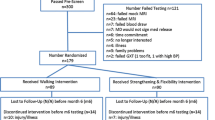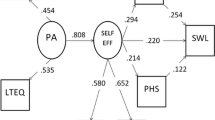Abstract
Purpose
Although physical activity has been associated with quality of life (QOL), the empirical evidence regarding the mechanisms underlying this relationship is limited. In the present study, we examined the mediating roles played by self-efficacy and health status in the physical activity–QOL relationship from baseline to 18-month follow-up in a sample of community-dwelling older adults.
Methods
Community-dwelling adults (N = 321, M age = 63.8 years) were recruited to participate in a cross-sectional study and were later contacted to participate in an 18-month follow-up. Individuals completed a battery of questionnaires assessing physical activity, self-efficacy, physical self-worth, disability limitations, and quality of life. A panel analysis within a covariance modeling framework was used to analyze the data.
Results
Overall, the model was a good fit to the data (χ2 = 61.00, df = 29, p < 0.001, standardized root mean residual = 0.05, Comparative Fit Index = 0.97) with changes in physical activity indirectly influencing change in life satisfaction from baseline to 18 months via changes in exercise self-efficacy, physical self-worth, and disability limitations independent of baseline relationships and demographic factors. Specifically, increases in physical activity were associated with increases in exercise self-efficacy which, in turn, was associated with higher physical self-worth and fewer disability limitations which were associated with greater life satisfaction.
Conclusions
The findings from this study suggest the relationship between physical activity and global QOL in older adults may be mediated by more proximal modifiable outcomes that can be targeted in physical activity programs and interventions.

Similar content being viewed by others
References
U.S. Census Bureau. (2008). Table 2: Projections of the population. National population projections, 2008. http://www.census.gov/population/www/projections/summarytables.html.
Nelson, M. E., Rejeski, W. J., Blair, S. N., Duncan, P. W., Judge, J. O., King, A. C., et al. (2007). Physical activity and public health in older adults: Recommendation from the American College of Sports Medicine and the American Heart Association. Circulation, 116, 1094–1105.
Chodzko-Zajko, W. J., Proctor, D. N., Fiatarone Singh, M. A., Minson, C. T., Nigg, C. R., Salem, G. J., et al. (2009). American College of sports medicine position stand. Exercise and physical activity for older adults. Medicine and Science in Sports and Exercise, 30, 992–1008.
McAuley, E., Konopack, J. F., Motl, R. W., Morris, K. S., Doerksen, S. E., & Rosengren, K. R. (2006). Physical activity and quality of life in older adults: influence of health status and self-efficacy. Annals of Behavioral Medicine, 31, 99–103.
Rejeski, W. J., & Mihalko, S. L. (2001). Physical activity and quality of life in older adults. The Journals of Gerontology Series A: Biological Sciences and Medical Sciences., 277, 64–66.
Tarlov, A. R., Ware, J. E., Greenfield, S., Nelson, E. C., Perrin, E., & Zubkoff, M. (1989). The medical outcomes study: An application of methods for monitoring the results of medical care. Journal of the American Medical Association, 262(7), 925–930.
Trine, M. (1999). Physical activity and quality of life. In J. Rippe (Ed.), Lifestyle medicine (pp. 989–997). Malden, MA: Blackwell Science.
Diener, E. (1984). Subjective well-being. Psychological Bulletin, 95, 542–575.
Stewart, A., & King, A. (1991). Evaluating the efficacy of physical activity for influencing quality of life outcomes in older adults. Annals of Behavioral Medicine, 13(3), 108–116.
McAuley, E., Doerksen, S. E., Morris, K. S., Motl, R. W., Hu, L., Wójcicki, T. R., et al. (2008). Pathways from physical activity to quality of life in older women. Annals of Behavioral Medicine, 36, 13–20.
Motl, R. W., McAuley, E., Snook, E. M., & Gliottoni, R. C. (2009). Physical activity and quality of life in multiple sclerosis: Intermediary roles of disability, fatigue, mood, pain, self-efficacy and social support. Psychology Health Medicine, 14, 111–124.
White, S. M., Wójcicki, T. R., & McAuley, E. (2009). Physical activity and quality of life in community dwelling older adults. Health and Quality of Life Outcomes. doi:10.1186/1477-7525-7-10.
Diener, E., & Diener, M. (1995). Cross-cultural correlates of life satisfaction and self-esteem. Journal of Personality and Social Psychology, 68(4), 653–663.
Lachman, M., Weaver, S., Bandura, M., Elliott, E., & Lewkowicz, C. (1992). Improving memory and control beliefs through cognitive restructuring and self-generated strategies. Journal of Gerontology, 47, 293–299.
Wójcicki, T. R., White, S. M., & McAuley, E. (2009). Assessing outcome expectations in older adults: The multidimensional outcome expectations for exercise scale. The Journals of Gerontology Series B:Psychological Sciences and Social Sciences., 64, 33–40.
Washburn, R. A., Smith, K. W., Jette, A. M., & Janney, C. A. (1993). The Physical Activity Scale for the Elderly (PASE): Development and evaluation. Journal of Clinical Epidemiology, 46, 153–162.
Washburn, R. A., & Ficker, J. L. (1999). Does participation in a structured high-intensity exercise program influence daily physical activity patterns in older adults? Research Quarterly for Exercise and Sport, 70, 201–205.
Washburn, R. A., McAuley, E., Katula, J., Mihalko, S. L., & Boileau, R. A. (1999). The physical activity scale for the elderly (PASE): Evidence for validity. Journal of Clinical Epidemiology, 52, 643–651.
McAuley, E. (1993). Self-efficacy and the maintenance of exercise participation in older adults. Journal of Behavioral Medicine, 16, 103–113.
McAuley, E., Konopack, J. F., Motl, R. W., Rosengren, K., & Morris, K. S. (2005). Measuring disability and function in older women: Psychometric properties of the late-life function and disability instrument. The Journals of Gerontology Series A: Biological Sciences and Medical Sciences, 60, 901–909.
Fox, K. R., & Corbin, C. B. (1989). The physical self-perception profile: Development and preliminary validation. Journal of Sport & Exercise Psychology, 11, 408–430.
Diener, E., Emmons, R. A., Larsen, R. J., & Griffin, S. (1985). The satisfaction with life scale. Journal of Personality Assessment, 49, 71–75.
Pavot, W., Diener, E., Colvin, C. R., & Sandvik, E. (1991). Further validation of the satisfaction with life scale: Evidence for the cross-method convergence of well-being measures. Journal of Personality Assessment, 57, 149–161.
Pavot, W., & Diener, E. (1993). Review of the satisfaction with life scale. Psychological Assessment, 5, 164–172.
Elavsky, S., McAuley, E., Motl, R. W., Konopack, J. F., Marquez, D. X., Hu, L., et al. (2005). Physical activity enhances long-term quality of life in older adults: Efficacy, esteem, and affective influences. Annals of Behavioral Medicine, 30, 138–145.
IBM. (1989–2010). SPSS statistics (version 19.0). Chicago, IL: IBM.
Muthén, L. K., & Muthén, B. O. (1998–2011). Mplus (version 6.0). Los Angeles, CA: Muthén & Muthén.
Arbukle, J. L. (1996). Full information estimation in the presence of incomplete data. In G. A. Marcoulide & R. E. Schumacker (Eds.), Advanced structural equation modeling: Issues and techniques (pp. 243–278). Mahwah: Lawrence Erlbaum Associates.
Enders, C., & Bandalos, D. (2001). The relative performance of full information maximum likelihood estimation for missing data in structural equation models. Structural Equation Modeling, 8, 430–457.
Enders, C. K. (2001). The impact of nonnormality on full information maximum-likelihood estimation for structural equation models with missing data. Psychological Methods, 6, 352–370.
Kessler, R. C., & Greenberg, D. F. (1981). Linear panel analysis: Models of quantitative change. New York: Academic Press.
Hu, L., & Bentler, P. (1999). Cutoff criteria for fit indexes in covariance structure analysis: Conventional criteria versus new alternatives. Structural Equation Modeling, 6, 1–55.
Browne, M. W., & Cudeck, R. (1993). Alternative ways of assessing model fit. In K. A. Bollen & J. S. Long (Eds.), Testing structural equation models (pp. 136–162). Newbury Park: Sage.
McAuley, E., Morris, K. S., Motl, R. W., Hu, L., Konopack, J. F., & Elavsky, S. (2007). Long-term follow-up of physical activity behavior in older adults. Health Psychology, 26, 375–380.
McAuley, E., Jerome, G. J., Elavsky, S., Marquez, D. X., & Ramsey, S. N. (2003). Predicting long-term maintenance of physical activity in older adults. Preventive Medicine, 37, 110–118.
Bandura, A. (2004). Health promotion by social cognitive means. Health Education & Behavior., 31, 143–164.
Blanchflower, D. G., & Oswald, A. J. (2008). Is well-being U-shaped over the life cycle? Social Science and Medicine, 66, 1733–1749.
Mroczek, D. K., & Spiro, A. (2005). Change in life satisfaction during adulthood: Findings from the veterans affairs normative aging study. Journal of Personality and Social Psychology, 88, 189–202.
Stone, A. A., Schwartz, J. E., Broderick, J. E., & Deaton, A. (2010). A snapshot of the age distribution of psychological well-being in the United States. Proceedings of the National Academy of Sciences, 107(22), 9985–9990.
Palgi, Y., & Shmotkin, D. (2010). The predicament of time near the end of life: Time perspective trajectories of life satisfaction among the old–old. Aging & Mental Health, 14(5), 577–586.
Thomas, P. A. (2011). Gender, social engagement, and limitations in late life. Social Science and Medicine, 73(9), 1428–1435.
Meeks, S., & Murrell, S. A. (2001). Contribution of education to health and life satisfaction in older adults mediated by negative affect. Journal of Aging and Health, 13(1), 92–119.
Centers for Disease Control and Prevention. (2010). Physical activity resources for health professionals. http://www.cdc.gov/physicalactivity/professionals/data/index.html.
Acknowledgments
This study was funded in part by a grant from the National Institute on Aging (AG020118) and a Shahid and Ann Carlson Khan Professorship in Applied Health Sciences at the University of Illinois Urbana Champaign.
Author information
Authors and Affiliations
Corresponding author
Rights and permissions
About this article
Cite this article
Phillips, S.M., Wójcicki, T.R. & McAuley, E. Physical activity and quality of life in older adults: an 18-month panel analysis. Qual Life Res 22, 1647–1654 (2013). https://doi.org/10.1007/s11136-012-0319-z
Accepted:
Published:
Issue Date:
DOI: https://doi.org/10.1007/s11136-012-0319-z




